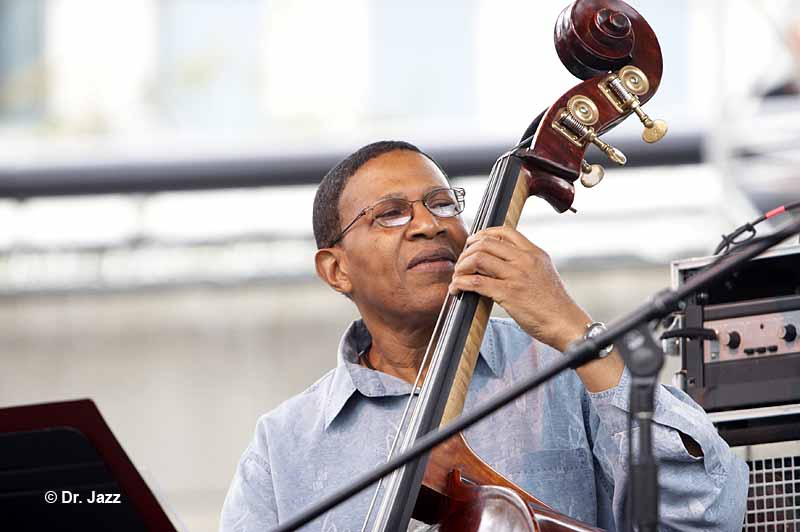In Memoriam: Bob Cranshaw, jazz bassist, musicians union advocate

By Patricia Myers
Melbourne Robert “Bob” Cranshaw, 83, who had an active career in music that included 50 years with saxophonist Sonny Rollins, also was known for his proactive involvement with the New York Musicians Union. The longtime Blue Note Records artist, who died Nov. 2 in Manhattan from stage 4 cancer, was a strong advocate for the rights of jazz musicians during more than two decades.
Because of his work in television, film and on Broadway, Cranshaw knew he was paid better than many jazz musicians. His involvement in the union started in the 1990s, when he began to advocate for the profession, particularly on creating better pension plans to ensure that musicians or their widows received royalties owed them. He said he wanted to help jazz musicians receive the same treatment and financial compensation that he did from his employment in other music genres and productions.
When he moved to New York in the 1960s, among the first people he met was bassist Milt Hinton, whom he had long idolized. Hinton took an immediate interest in the young musician’s career, and soon recommended him for recording dates and other music jobs. That led to Cranshaw’s career of performing for hundreds of television shows and film and television scores. He was part of “The Blue Note Story,” a 90-minute documentary of the jazz label, and once said he worked steadily for so long because he managed to avoid drugs and other temptations of that era of jazz life. “I did a lot of Blue Note dates because I was on time,” he said. “If you said, ‘Be there at a certain time,’ I was there. It was a business for me at that point.”
Cranshaw’s professional relationship with Rollins started after the tenor saxophonist’s two-year hiatus from music. After joining the band, the bassist played on the 1962 album “The Bridge” that marked Rollins’s return to the jazz scene after two years of solitary practice on New York’s Williamsburg Bridge. For the next 50 years, Cranshaw played on more than 20s albums led by Rollins, including the Grammy Award-winning “This Is What I Do” (2000) and “Without a Song: The 9/11 Concert” (2005).
Cranshaw also was renowned for creating the catchy bass line for trumpeter Lee Morgan’s 1964 soul-jazz hit, “The Sidewinder.” Among other notable recordings he played on were “Idle Moments” (1963) by guitarist Grant Green, “Inner Urge” (1964) with saxophonist Joe Henderson, and “Movin’ Wes” (1964) with guitarist Wes Montgomery.
Cranshaw worked for more than 25 years with “Sesame Street,” recording the TV show’s theme song by Joe Raposo, as well as “(It’s Not Easy) Bein’ Green” and “Sing.” From 1975 to 1980, Cranshaw was the bassist with the original studio band of NBC’s “Saturday Night Live,” working with keyboardist Paul Shaffer, who later became the director of the band on “The Late Show with David Letterman.”
He previously had been in the studio band of “The David Frost Show” from 1969 to 1972, working with pianist Billy Taylor. In the early 1980s, he was the musical director for one of Dick Cavett’s talk shows. In addition to his studio work, Cranshaw performed in Broadway pit orchestras and for visiting singers, including Bing Crosby, Peggy Lee, Judy Collins and Frank Sinatra. He played on several tracks on Paul Simon’s 1973 album “There Goes Rhymin’ Simon.” Cranshaw also was a founding member of MJT + 3 (Modern Jazz Two) that included Frank Strozier on alto saxophone, Harold Mabern on piano, Willie Thomas on trumpet and Walter Perkins on drums.
During the early 1970s, Cranshaw was among the first jazz bassists to adopt the electric bass guitar as his primary instrument. Back injuries from a car accident caused him to switch to the smaller amplified electric bass, although he continued to perform occasionally on acoustic bass. He initially was criticized by jazz purists, who maintained that the electric bass was used more in rock music and didn’t fit into jazz sounds. But Cranshaw’s approach created more subtlety to its sound by using the same touch, musical phrasing and jazz techniques that he had on the upright bass. “A bass is a bass. That’s my attitude,” he once said in the interview. “I know that the jazz guys don’t dig the electric, so I gotta make it sound, and I gotta make it feel, like I’m playing the string bass.”
Cranshaw was born Dec. 10, 1932, in Chicago. He grew up in a solidly middle-class community in Evanston, Ill., where his father was a choir director. As a child, he often visited church basements in Evanston because he could feel the bass notes of the organ and choirs through the foundation of the building. He played in the school orchestra and learned to read music by the time he graduated. He received a bachelor’s degree from Chicago’s Roosevelt University, and then served in the Army before starting his music career in Chicago.
Cranshaw’s philanthropic work on behalf of his fellow musicians has left an indelible imprint on his profession and the world of jazz.
Categories: News